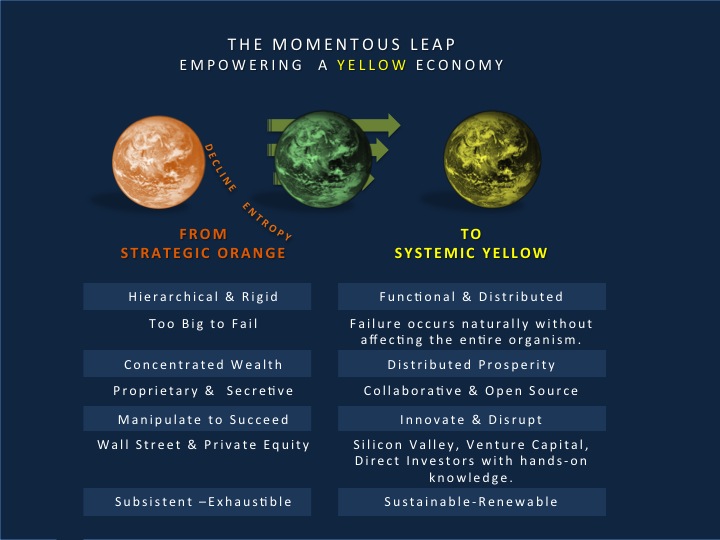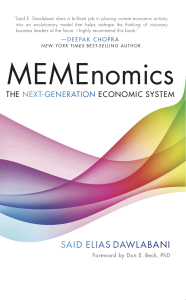I had an interesting conversation last week with Said Dawlabani, author of the new book, MEMEnomics: The Next Generation Economic System.
Dawlabani charts historical economic systems according to their position on the spiral of development. He has worked with Don Beck, co-author of Spiral Dynamics, for over ten years, and definitely stands on Beck’s shoulders with a virtuoso understanding of the Spiral Dynamics’ model of evolution, and a brilliant application of its explanatory power to the dismal science of economics. As I told Said early in our conversation, this is the book I’ve been waiting for, and I finished reading it with a much more sophisticated understanding of the karmas of the historical economic systems humanity has created, especially the ones that are online (and fighting with each other) right now.
Every developmental altitude has its own economic system, and the natural forces of human development inevitably create economies that mirror the values of every culture and time.
Starting with the dawning of humanity, the archaic stage (infrared altitude) exhibits a primitive, instinctual focus on day-to-day survival. That’s as complex as the economy gets at that stage. The second stage, tribal (magenta altitude) continues to emphasize survival but is more complex, with longer survival timelines (a season instead of a day), with differentiated functions among members of the tribe, the emergence of trade and bartering, and a communal, self-sacrificial allegiance to elders and tribal customs.
Red–“Fiefdoms of power”
It’s when we get to the next stage, the warrior stage of development (red altitude), that things become more relevant to our contemporary life. Naming it the “Fiefdoms of Power Cycle,” Dawlabani points out that the identifying attributes of the warrior stage — a big boss, economic exploitation and empire building — characterize the economy of the United States in the first part of our history. This stage really kicked in at the end of the Civil War, and the late 1800‘s saw the rise of John D. Rockefeller, Andrew Carnegie, J.P. Morgan, Cornelius Vanderbilt and the roster of robber barons who built huge enterprises through the force of their own will, unimpeded by governmental or labor power structures that might keep them in check.
Amber–“Patriotic prosperity cycle”
This era came to an end with the Great Depression and the beginning of World War II, giving rise to an economy built on the values of the traditional stage of development (amber altitude), with a renewed focus on the common good (recapitulating the communal vibe of the tribal meme). Called the “Patriotic Prosperity Cycle”, this economic system seeks to reign in the excesses of red exploitation using government regulation, taxation, and powerful labor movements, all of which grew enormously over the subsequent decades. This is the era of the great social goals such as winning the war, building a national infrastructure of highways, airports and seaports, and supporting an educated middle class that exhibits good, bourgeois values such as thrift, hard work and the ability to delay gratification.
In the United States, the traditionalist economic stage thrived in the postwar era, until it eventually played itself out with the economic malaise of the mid 1970’s. This was when taxes rates had spiked to seventy to eighty percent of income, inflation was as high as twenty percent and labor unions were proving to be as ruthless as the big bosses had been in the previous stage.
Orange–“Only money matters”
Enter Ronald Reagan in 1980, and a new stage of economic development based on the values of modernity: freedom from government coercion, and a resurgence of autonomy. Tax rates we’re cut to under 30% and labor unions lost power. Dawlabani calls this the age of “Only Money Matters” and it kicked off a new trend of laissez-faire government, deregulation and free trade.
As he writes, “this newly empowered Enterprise MEME had found a partner in government that fully understood its right to make a profit over all other considerations. A business owner’s decision to relocate the factory to China became merely an accounting matter without a struggle with the moral obligation to provide local jobs, or a consideration of the patriotic duty to participate in the collective prosperity of America as a whole.”
This was the beginning of the end of traditional manufacturing in America, and during Reagan’s first term America permanently lost over 2.5 million manufacturing jobs, and wealth was redistributed away from the working-class to educated, white-collar workers and, of course, owners and shareholders. There was an upside as well, of course. As the economy grew, inflation was tamed and a new economy arose based on service, technology and knowledge.
This modern economic system has gone for the last thirty years, and is now in its own phase of disintegration. America has become less equal, and more stratified and economically immobile. Over ninety percent of the increase in wealth has gone to the top two percent of the population.
And of course the most dramatic mark of the end of this era is the real estate and financial meltdown that began in 2008. Dawlabani begins MEMEonomics with a vivid retelling of the crises, and the come-down of Alan Greenspan, the Ayn Rand protege who became a god of the modern economy as Chairman of the Federal Reserve, and after the meltdown admitted to Congress that he wasn’t sure his theories really worked anymore.
“If anything, President Obama is at least a decade or so ahead of this time. He’s meeting life conditions at the worst time possible. He could’ve been an ideal yellow [teal altitude] leader, but life conditions were exiting a catastrophic phase of the orange system, so his leadership has been arrested to where life conditions and society are.” ~Said Dawlabani
Green–“Democratization of information”
But the beat goes on, and now we are seeing the rise of a new economy based on the values of the green postmodern meme, which Dawlabani refers to as the “Democratization of Information” economy. This is largely driven by technological innovations (the internet, social media, etc.) that are replacing proprietary and secretive practices of past economic systems with open source and collaborative technologies. The “old media” in general has had to adapt or die because today everyone is a consumer and creator of information. Anybody can publish a book, or music or art, but almost nobody makes much money.
We’re still orange enough, however, so that those folks who do make money make gobs of it. But the inequality of rewards is not feeling right to more and more people. Culturally we are seeing the ascent of egalitarian and humanitarian values that are seeking a redistribution of wealth and opportunity. Obamacare is a prime example of the type of policies that arise out of this value structure, and if the theory is correct we will be seeing more such similar innovations.
I like Dawlabani’s thinking because it helps us understand that despite the endless political battles over economic ideology in real time, the larger forces at work are actually evolutionary, and if the evolutionary theories are correct, inevitable.
Teal and turquoise–“Natural systems and functional flow”
Of course green “Democratization of Information” is not the end of the road. Next up is the momentous leap into integral territory, and the emergence of an economy based on the values of the teal stage of development, which Dawlabani describes as exhibiting “Natural Systems and Functional Flow.” This economy “distributes the wealth and the abundance of innovation to anyone willing to participate.” It is both global and local at the same time, relying on vast infrastructure of informed global citizens.
This emerging integral structure, which he estimates currently encompasses five to seven percent of global GDP, is coming on faster than any previous structure, as evolution is accelerative. Dawlabani writes “today, a group of women weavers in a remote village in Africa can find willing buyers for their garments anywhere in the world with nothing more than a satellite phone equipped with a good camera. This is how the knowledge economy can bring prosperity to a purple meme [magenta altitude] that would have taken decades, if not centuries, to reach under the old system.”
Dawlabani provides one of the best outlines for the emerging integral economy that I have run across. Fundamental to this arising of a more conscious economic system is the arising of more conscious human beings, particularly leaders who eschew value systems which are “limited to expressions of selfish interests in favor of one that sees the essential need for all life forms on the planet to continue to exist.”
“Here, business leaders look beyond the traditional model that looks at maximizing stockholder value and the accumulation of vast individual wealth as their primary objective to see the proper distribution of wealth as a basic quality of life issue.”
“Traditional market analysis for product viability is replaced by a deep conviction that if you create a product that raises the consciousness of the consumer, it will create its own new market.”
 Dawlabani points to several real-life exemplars of this emerging integral economy, such as Google, Apple and Whole Foods. Of Google he writes, “the essence of second-tier Natural Design is reflected in Google’s marginal advantage on an internet-fueled massive scale that simultaneously manages all three value systems, blue [traditional], orange [modern] and green [post-modern], and a functional flow towards a superordinate goal, respecting each, embracing the healthy aspects of each and aligning each towards companies goals, project goals and Google’s overarching social goal of not being evil.”
Dawlabani points to several real-life exemplars of this emerging integral economy, such as Google, Apple and Whole Foods. Of Google he writes, “the essence of second-tier Natural Design is reflected in Google’s marginal advantage on an internet-fueled massive scale that simultaneously manages all three value systems, blue [traditional], orange [modern] and green [post-modern], and a functional flow towards a superordinate goal, respecting each, embracing the healthy aspects of each and aligning each towards companies goals, project goals and Google’s overarching social goal of not being evil.”
MEMEnomics is a powerful book that places the often confused and confusing world of economics into a coherent context. It has given me not only a more complex and nuanced understanding of economic history, but a new comfort with and optimism for our economic future. I highly recommend it.
Podcast: Download
Subscribe: Google Podcasts | RSS








I just want to suggest that the economic analysis that focuses on the existence of what economists call ‘economic rent’ which is the polite way of saying ‘unearned income’ appears to me to be in harmony with the concept of s systemic yellow economy.
Unearned income is estimated to be 40+% of GNP and is the root cause of the disparity of wealth. This is so because over the centuries in previous culturally driven economies the ownership of assets mainly land and natural resources that give rise to unearned income has been concentrated in the hands of the elites. Slavery was a form of economic organization which was only, always and completely about the private pocketing of unearned income. Humanity rejected slavery as the first step in the direction of preparation for a real economy of distributed prosperity. Unearned income is defined as the pocketing of a value one does not produce. This is obvious in the case of slavery but not so obvious for most people without it being pointed out. The bulk of unearned income comes from economic values created by the society/community of all people as is clearly the case with the value of land and natural resources but applicable to many other things (monopoly of capital, patents, copyrights, interest charged by banks on money created out of thin air, most of the illusory wealth created by the current financial sector, under charge by governments for access to publicly owned land and resources including the electro-magnetic spectrum and more).
The idea expressed over a century ago by Henry George, an American political economist and social philosopher, was to shift taxation off of earned income from labor and real capital investment in the real economy onto unearned incomes for the purpose of creating the ‘distributed prosperity’ now envisioned as a main characteristic for what you are calling here the systemic yellow economy.
Unearned income is so huge that taxing it could allow all taxation of earned incomes to be eliminated along with the unintended negative economic results that stymie public policy and general prosperity. I predict that this idea will become part of the discussion about moving into the yellow system economy.
This book has been a bit of a conundrum for me. On the one hand I loved it, simply because I love the integral view and Spiral Dynamics in particular, being applied to history, economics, or pretty much anything. On the other hand, I read it right after another great integral book on economics, or at least business leadership: Fredric Laloux’s “Reinventing Organizations”
http://www.amazon.com/Reinventing-Organizations-Creating-Inspired-Consciousness-ebook/dp/B00ICS9VI4/ref=sr_sp-atf_title_1_1?s=digital-text&ie=UTF8&qid=1404712593&sr=1-1&keywords=frederic+laloux
Laloux’s book left me inspired and hopeful, while Dawlabani’s left me feeling a bit heavier and less inspired. I think partially it was the tone of the book. It seemed that Dawlabani’s had a somewhat academic tone, which to me resonates more with an orange altitude, while Laloux’s embodied the Teal or at least Green altitude by being written from a much more refreshing perspective (to my ears.) Am I the only one who felt this way?
Again, I liked much about Dawlabani’s book (and I am no economist or even academic, so who am I to judge?) but I felt that his visions (or predictions) for the future seem to see some powerful “elite” as providing them for us, while Laloux’s solutions seem to be more “bottom-up” and do not depend on a traditional “elite” (Yes, I know, obviously, when we are talking about integralism we can’t really complain about “elites”–after all: integral consciousness is very elitary in the sense that it emerging in only a tiny minority at this time–still: Dawlabani’s elite is the traditional elite of powerful, large corporations, governments and even academia.)
For example, looking at the 3 companies that are mentioned as representing teal consciousness:
I have worked (though only as a contractor) at Apple and have friends who worked at Google (until they burned out) and I must say that while their methods–the HOW–might have some elements of green or even teal in them, their WHY seems to me to be solidly situated on the orange altitude. They are firmly modern companies with firmly modern goals (shareholder value) and seem quite exploitative in many ways (some would say especially in the way they co-opt green and teal methodologies and ideas for orange goals.)
Contrast this to the descriptions of companies like Buurtzorg and Holacracy.org (and others described in Laloux’s book) which seem to have teal much more at their core.
Wholefoods is the one company mentioned in both books, although Laloux puts them more on the green altitude–with some teal and orange mixed in (I guess a purely green company might be a contradiction in itself??…)
Anyway, I just felt like seeing if anyone who read both books has had a similar emotional reaction to them as I had. (Again I liked both books, but one left me feeling much more hopeful than the other.)
Thanks for listening!